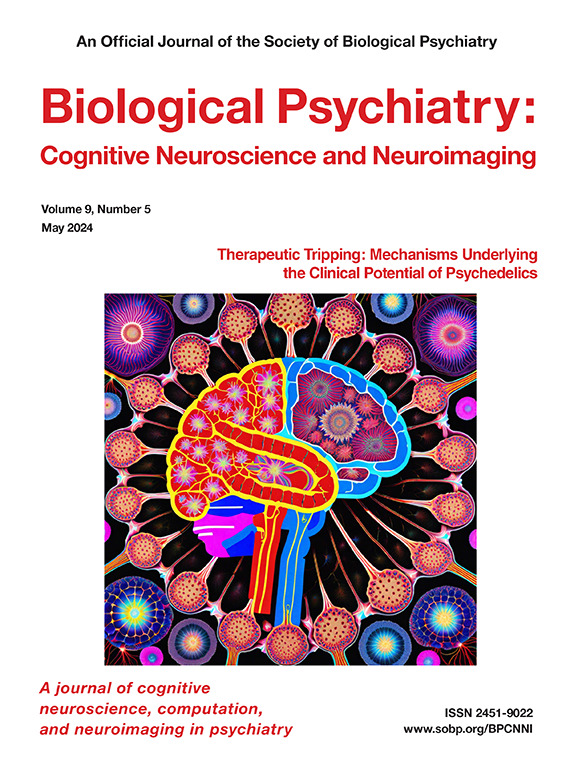A Randomized Controlled Trial of Medial Prefrontal Cortex Theta Burst Stimulation for Cocaine Use Disorder: A Three-Month Feasibility and Brain Target Engagement Study
IF 4.8
2区 医学
Q1 NEUROSCIENCES
Biological Psychiatry-Cognitive Neuroscience and Neuroimaging
Pub Date : 2025-06-01
DOI:10.1016/j.bpsc.2024.11.022
引用次数: 0
Abstract
Background
Cue-induced craving precipitates relapse in drug and alcohol use disorders. Theta burst stimulation (TBS) to the left frontal pole of the medial prefrontal cortex (MPFC) has previously been shown to reduce drinking and brain reactivity to alcohol cues. In this randomized, double-blind, sham-controlled target engagement study, we aimed to assess whether TBS has similar effects in individuals with cocaine use disorder.
Methods
Thirty-three participants in intensive outpatient treatment received either real or sham TBS over 10 sessions across 3 weeks (36,000 pulses total; continuous TBS, 110% resting motor threshold, 3600 pulses/session). TBS was administered on days of behavioral counseling. Twenty-five individuals completed all 10 TBS sessions. Brain reactivity to cocaine cues was measured using functional magnetic resonance imaging at baseline, 1 month, 2 months, and 3 months.
Results
Cocaine abstinence during the 3-month follow-up period was greater in the real TBS group (1-month: 92.0%, 2-month: 100.0%, 3-month: 85.0%) than sham (1-month: 66.6%, 2-month: 66.6%, 3-month: 66.6%), although the difference was not statistically significant (1-month odds ratio [OR] = 6.00, p = .14; 2-month OR = 14.30, p = .09; and 3-month OR = 2.75, p = .30). However, there was a significant effect on cocaine cue reactivity (treatment effect: F1,365 = 8.92, p = .003; time × treatment interaction: F3,365 = 12.88, p < .001). Real TBS reduced cocaine cue reactivity in the MPFC (F3,72 = 5.46, p = .02), the anterior cingulate (F3,72 = 3.03, p = .04), and the insula (F3,72 = 3.60, p = .02).
Conclusions
This early-stage trial demonstrates that TBS to the MPFC reduces brain reactivity to cocaine cues in key nodes of the salience network in treatment-seeking cocaine users. Future, well-powered trials are warranted to evaluate clinical efficacy outcomes.
内侧前额叶皮层θ脉冲刺激治疗可卡因使用障碍的随机对照试验:为期三个月的可行性和大脑目标参与研究。
背景:线索诱导的渴望促使药物和酒精使用障碍的复发。对内侧前额叶皮层(MPFC)左额极的θ波爆发刺激(TBS)已经被证明可以减少饮酒和大脑对酒精线索的反应。这项随机、双盲、假对照的目标参与研究旨在评估TBS对可卡因使用障碍(CUD)患者是否有类似的效果。方法:33名接受强化门诊治疗的参与者在3周内接受了10次真实或虚假TBS治疗(共36,000次脉冲;连续TBS,静息运动阈值110%,3600脉冲/次)。TBS是在行为咨询期间进行的。25个人完成了所有10个TBS疗程。在基线、1个月、2个月和3个月时使用功能磁共振成像测量大脑对可卡因线索的反应。结果:3个月随访期间,真TBS组可卡因戒断率(1个月:92.0%,2个月:100.0%,3个月:85.0%)高于假TBS组(1个月:66.6%,2个月:66.6%,3个月:66.6%),但差异无统计学意义[1个月:6.00,p=0.14;2个月OR=:14.30, p=0.09, 3个月OR=2.75, p=0.30]。然而,对可卡因线索反应性有显著影响(治疗效果:f1365 = 8.92, p=0.003;时间*治疗相互作用:F3,365=12.88, p3,72=5.46, p=0.02),在前扣带(F3,72=3.03, p=0.04)和岛叶(F3,72=3.60, p=0.02)。结论:这项早期试验表明,在寻求治疗的可卡因使用者中,对MPFC进行TBS可以降低大脑对可卡因线索的反应性。未来有必要进行有力的试验来评估临床疗效结果。
本文章由计算机程序翻译,如有差异,请以英文原文为准。
求助全文
约1分钟内获得全文
求助全文
来源期刊

Biological Psychiatry-Cognitive Neuroscience and Neuroimaging
Neuroscience-Biological Psychiatry
CiteScore
10.40
自引率
1.70%
发文量
247
审稿时长
30 days
期刊介绍:
Biological Psychiatry: Cognitive Neuroscience and Neuroimaging is an official journal of the Society for Biological Psychiatry, whose purpose is to promote excellence in scientific research and education in fields that investigate the nature, causes, mechanisms, and treatments of disorders of thought, emotion, or behavior. In accord with this mission, this peer-reviewed, rapid-publication, international journal focuses on studies using the tools and constructs of cognitive neuroscience, including the full range of non-invasive neuroimaging and human extra- and intracranial physiological recording methodologies. It publishes both basic and clinical studies, including those that incorporate genetic data, pharmacological challenges, and computational modeling approaches. The journal publishes novel results of original research which represent an important new lead or significant impact on the field. Reviews and commentaries that focus on topics of current research and interest are also encouraged.
 求助内容:
求助内容: 应助结果提醒方式:
应助结果提醒方式:


